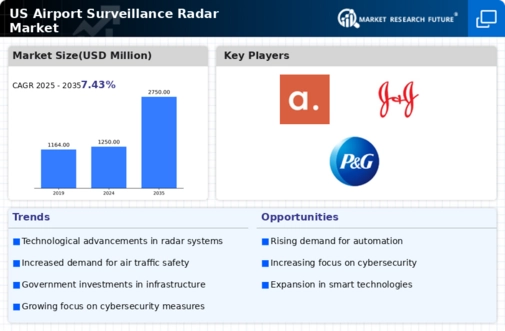The airport surveillance radar market is characterized by a competitive landscape that is increasingly shaped by technological advancements and strategic collaborations. Key players such as Raytheon Technologies (US), Northrop Grumman (US), and Lockheed Martin (US) are at the forefront, focusing on innovation and digital transformation to enhance their operational capabilities. These companies are not only investing in research and development but are also pursuing strategic partnerships to bolster their market positions. The collective strategies of these firms indicate a trend towards integrated solutions that leverage advanced technologies, thereby intensifying competition within the sector.
In terms of business tactics, companies are localizing manufacturing and optimizing supply chains to enhance efficiency and responsiveness to market demands. The competitive structure of the market appears moderately fragmented, with several key players exerting influence. This fragmentation allows for a diverse range of offerings, yet the presence of major firms like Thales Group (US) and Honeywell International (US) suggests a significant concentration of market power among a few dominant entities.
In November 2025, Raytheon Technologies (US) announced a partnership with a leading technology firm to develop next-generation radar systems that incorporate artificial intelligence (AI) capabilities. This strategic move is likely to enhance the accuracy and efficiency of surveillance operations, positioning Raytheon as a leader in innovation within the market. The integration of AI into radar systems could potentially redefine operational standards and set new benchmarks for performance.
Similarly, in October 2025, Northrop Grumman (US) unveiled a new radar technology designed to improve detection capabilities in adverse weather conditions. This development underscores the company's commitment to addressing critical operational challenges faced by airports. By enhancing the reliability of surveillance systems, Northrop Grumman is likely to strengthen its competitive edge and appeal to a broader customer base.
In September 2025, Lockheed Martin (US) expanded its collaboration with federal agencies to enhance airport security measures through advanced radar technologies. This initiative not only reflects Lockheed's strategic focus on public safety but also indicates a proactive approach to regulatory compliance and market responsiveness. Such collaborations may enhance the company's reputation and foster trust among stakeholders.
As of December 2025, current trends in the airport surveillance radar market are increasingly defined by digitalization, sustainability, and the integration of AI technologies. Strategic alliances are playing a crucial role in shaping the competitive landscape, as companies seek to leverage shared expertise and resources. Looking ahead, it appears that competitive differentiation will evolve from traditional price-based competition to a focus on innovation, technological advancements, and supply chain reliability. This shift may redefine market dynamics, compelling companies to prioritize value creation through cutting-edge solutions.














Leave a Comment